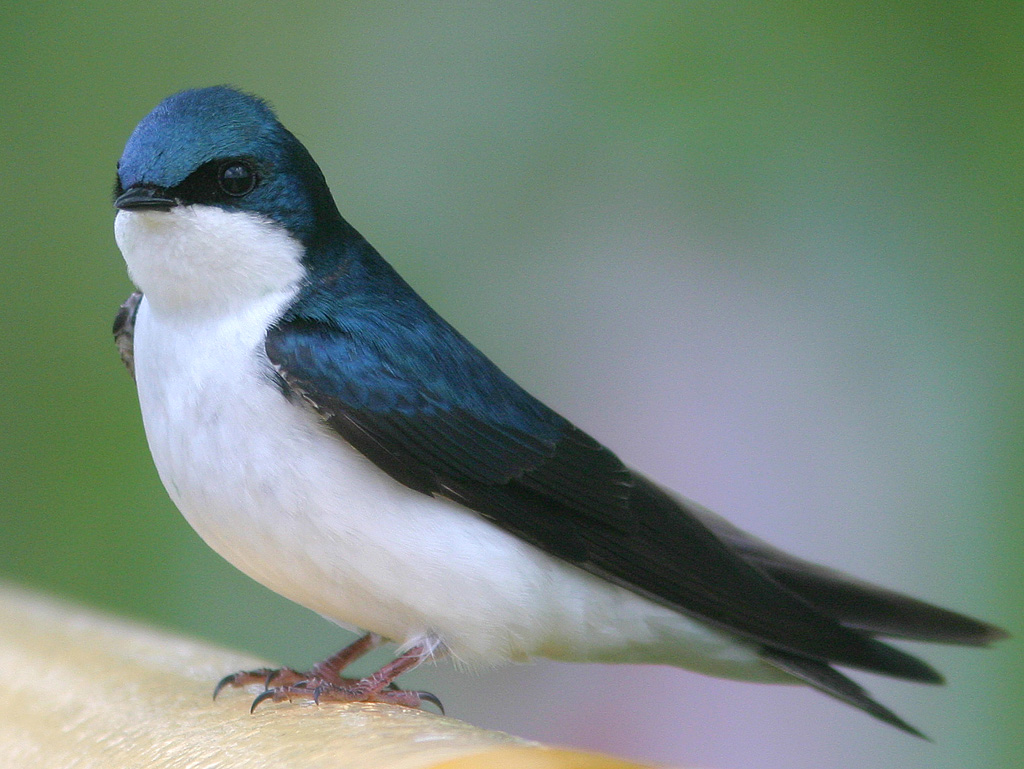- Tree Swallow
Taxobox
name = Tree Swallow
status = LC | status_system = IUCN3.1

image_width = 250px
range_
range_map_width = 200px
regnum =Animal ia
phylum = Chordata
classis = Aves
ordo = Passeriformes
familia = Hirundinidae
genus = "Tachycineta "
species = "T. bicolor"
binomial = "Tachycineta bicolor"
binomial_authority = (Vieillot, 1808)
synonyms ="Iridoprocne bicolor"The Tree Swallow, "Tachycineta bicolor", is a migratorypasserine bird that breeds inNorth America and winters inMexico ,Central America and theCaribbean . It is a very rare vagrant to westernEurope .This
swallow averages 13.5 cm (5 inches) long and weighs about 20g. The bill is tiny. The adult Tree Swallow has iridescent blue-green upperparts, white underparts, and a very slightly forked tail. The female usually has duller colours than the male, often more greenish than the more bluish male. The juvenile plumage is dull grey-brown above and may have hint of a gray breast band.Breeding
Tree Swallows nest in natural or artificial cavities near water and are often found in large flocks. They readily use nest boxes, including those built for
bluebird s. Declines in cavity-builder populations are resulting in fewer natural nesting sites for Tree Swallows, although the swallow population remains healthy.The Tree Swallow nest consists of multiple layers of grasses and thin twigs, and is lined with large feathers from other species. The female lays 4 to 7 white eggs and incubates them by herself. The eggs hatch in about 14 days and the hatchlings are
altricial . The hatchlings typically fledge in 16-24 days. While there are young or eggs in the nest, adults frequently dive bomb intruders (including curious humans) and attempt to drive them from the area. Tree Swallows are known to "fight" over feathers in mid-air for reasons which are still under investigation. There is some speculation that this is a form of play.Tree Swallows are typically single-brooded, although they may attempt a second nest if the first fails early in the season. There are records of parents raising two successful broods in a season.
They subsist primarily on a diet of insects, sometimes supplemented with small quantities of fruit. They are excellent fliers and take off from their perch and acrobatically catch insects in their bills in mid-air.
ee also
*
Barn Swallow - many similar characteristics
*Purple Martin - Barn & Tree Swallows are often misnamed "Purple Martins"References
* Database entry includes justification for why this species is of least concern
External links
* [http://www.mbr-pwrc.usgs.gov/Infocenter/i6140id.html Tree Swallow] - USGS Patuxent Bird Identification InfoCenter
* [http://www.birds.cornell.edu/AllAboutBirds/BirdGuide/Tree_Swallow.html Tree Swallow species account, Cornell Lab of Ornithology]
* [http://www.sdakotabirds.com/species/tree_swallow_info.htm Tree Swallow information and photo, South Dakota Birds and Birding]
* [http://animaldiversity.ummz.umich.edu/site/accounts/information/Tachycineta_bicolor.html Tree Swallow] at "Animal Diversity Web"
* [http://www.treeswallowprojects.com/index.html How to create and manage nest box projects for Tree Swallows]
* [http://ibc.hbw.com/ibc/phtml/especie.phtml?idEspecie=5321 Tree Swallow videos] on the Internet Bird Collection
* [http://vireo.acnatsci.org/search.html?Form=Search&SEARCHBY=Common&KEYWORDS=tree+swallow&showwhat=images&AGE=All&SEX=All&ACT=All&Search=Search&VIEW=All&ORIENTATION=All&RESULTS=24 Tree Swallow photo gallery] VIREO
Wikimedia Foundation. 2010.
